By: Alain Briot
Alain Briot is one of the most successful landscape photographers working in the American Southwest today. His work is widely exhibited and collected. His monthly columns for this web site, of which this is one, is calledBriot’s View.
An extensive interview with Alain is included in Issue #1 ofThe Luminous Landscape Video Journal.
Next to “How can I sell my work?” one of the questions I am most often asked is “Where can I sell my work?” Well, an excellent venue where to sell your work is at art shows. However, doing shows is a specific venue which requires specific equipment and approach. For several years now I have been selling my work at theEl Tovar HotelatGrand Canyon National Parkin Arizona. Although I have a specific agreement to use this space, I do have to put up the show and take it down everyday. I also have to operate in an outdoor setting. For all these reasons there is much to learn from my experience if you are interested in doing art shows yourself. Read on!
The Show
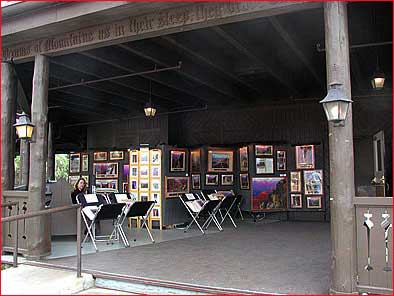
Art show at the El Tovar Hotel, Grand Canyon National Park.
In art shows as in real estate, location is everything. As they say, there are three things that matter: 1-location; 2-location; and 3-location. Of course when doing a show other things matter — such as the work you offer for sale, the prices you ask, and the quality of your display. But if you do all this correctly in the wrong location it will be difficult to be successful.
So where is the right location? Well, basically the right location is where customers looking to purchase work such your are going to be. Remember that it is easier to go to where the customers are than to have the customers come to you. In my case the best location I have found so far is at theEl Tovar HotelatGrand Canyon National Park. Don’t despair if you cannot go there or this is not the place where you want to be as there are doubtless many other locations that will work great for you.
Before we go any farther let’s think about why the El Tovar is such a great location. First, it is in a National Park, and arguably in the most famous National Park, the Grand Canyon — a park that people come from all over the world to visit — 5 million of them a year. That’s a lot of potential customers and nearly all of them will be walking in front of the El Tovar.
Second the El Tovar is a hotel which means that you can count on the hotel guests to look at your work and invest in it. In this sense any hotel in a touristic location would work reasonably well as it will insure a steady flow of visitors who are here because they are staying at the hotel.
Third the El Tovar is 60 feet (at the most) from the rim of the Grand Canyon thereby guaranteeing that people who came to see the Grand Canyon will see your work while they walk in front of the hotel.
Fourth the El Tovar is in Grand Canyon Village and right along the rim trail that leads to and from the Bright Angel Trail, one of the two most-heavily-used trails in the Grand Canyon (the other is the Kaibab Trail). This means that hikers will see your work either on their way down into the canyon or out of the canyon. Since hiking the Grand Canyon is a major endeavor, indeed often a once-in-a-lifetime adventure, many of these hikers will want to bring back a professional photograph showing where they have been. If you have the goods, you will be in business. In my case I do extremely well with photographs of the Bright Angel and Kaibab trails.
Fifth, the El Tovar is up the hill from the Grand Canyon Railroad Station which means that people coming out or returning to the train walk right past my display. Again many of these people, who only get to stay 3 hours at Grand Canyon, will want to bring a professional photograph as a souvenir of their visit.
So there you are, on the best place on earth, with your work, and ready to rock and roll. To place all the chances on your side you need to have the nicest looking display you can possibly have and you need to think carefully about which photographs, and which size, you want to display. Remember one of the basic rules of marketing: you sell what you show.
How to Display Your Work at a Show
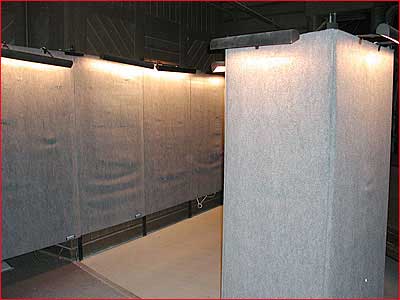
Carpet-covered displays are both attractive and practical. Their only drawback is their weight. But, if you don’t have to move them everyday they may be the perfect solution. In my case they stay put for the whole season, from March to November, so weight isn’t a problem.
The photographs in this article give you a very good idea of the way I display my work, the sizes I show, and the framing and matting styles I favor. My approach is based on years of experience and it works very well for me. It may or may not work for you, the best way to know that is to try it or try different approaches.
3-How to pack and transport your work so it doesn’t get damaged Selling your work at shows means setting up and taking down your frames and your prints every day, as in my case, or at least at the beginning and at the end of the show if you can leave your work up for the whole show. At any rate, if you do a lot of shows, this means a tremendous amount of packing, unpacking and transportation to and from the show.
The photographs below show my approach to protecting my work. Again this approach works well for me and I have not had much damage since I started using it. In the beginning I broke a number of pieces and thus had to learn fast! Again, study these photographs as they will teach you more than a lengthy textual explanation.
Where to Get Your Own Displays
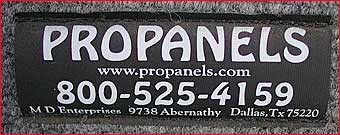
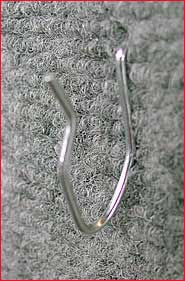
The best way to hang artwork on carpet-covered displays is with curtain hooks.

How to display 15 photographs in the least amount of space: use a room-separation print display! One of my best selling tools.

Folding print bins,are an excellent way to display and sell unframed prints. Plus, they don¹t take much space when folded which makes them easy to transport. See the manufacturer listings at the end of this article to find out where you can purchase these.

Lighting is important, and should be both elegant and powerful. Those are elegant but not powerful enough. They were mandated by the National Park Service.
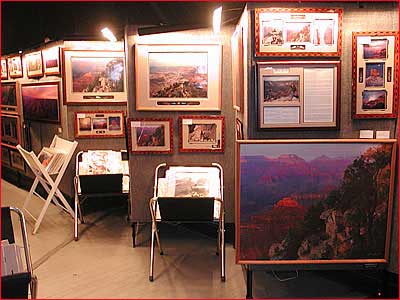
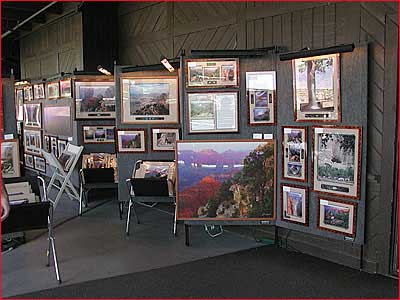
Your show should look great day and night hence the importance of good lighting. Here, nighttime view on the left and daytime view on the right.
Artist Statement

One of the most important framed pieces in the show is not for sale: a well-written and nicely presented artist statement is a must. It says a lot more to the customer than you could in an hour and takes no effort on your part once you have it done. Mine includes my biography/artist statement, a photograph of myself “in the office” and several testimonials from past customers.
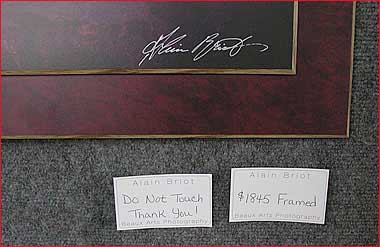
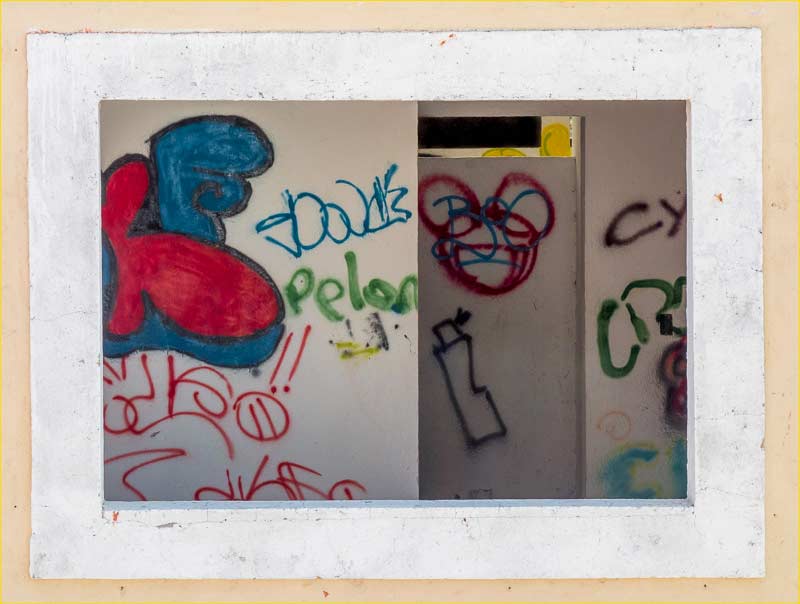
All your work needs to be clearly priced. Signs stating your policies, such as this “Do not touch” sign, also need to be prominently displayed. This way if a dispute arises there can be no question about your attempt to inform the public.
How to Pack and Transport Your Work so it Doesn’t Get Damaged
Selling your work at shows means setting up and taking down your frames and your prints every day, as in my case, or at least at the beginning and at the end of the show if you can leave your work up for the whole show. At any rate, if you do a lot of shows, this means a tremendous amount of packing, unpacking and transportation to and from the show.
The photographs below show my approach to protecting my work. Again this approach works well for me and I have not had much damage since I started using it. In the beginning I broke a number of pieces and thus had to learn fast! Again, study these photographs as they will teach you more than a lengthy textual explanation.
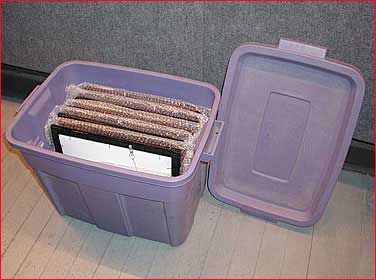
Protecting frames during transportation is essential. We wrap each frame in bubble wrap and store them in plastic containers.
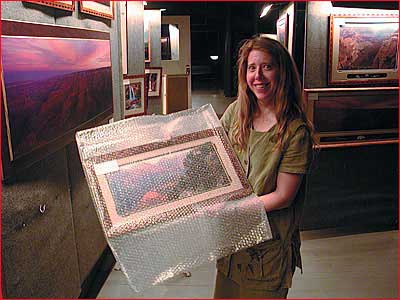
How to wrap a framed piece in bubble wrap.
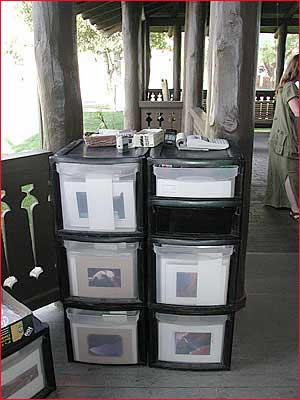
Protecting unframed prints, here 8×10’s, is equally important. These plastic drawers stack up on top of each other and double up as “office.” The two smaller drawers on the top right side are used to store office supplies.
How to Set Up an Outdoor Office and Frame Shop
Last but not least, selling at shows also means setting up a temporary, and sometimes impromptu, office, in a setting which may at times be challenging to say the least. Here is my time-tested approach, one that I feel comfortable with. How to set up your “office” at a show is largely a matter of personal preference. Keep in mind that you will have to do potentially a lot of transactions, and some of those may be significant both in price and in size. You also will need to keep track of orders that are to be shipped so that you don’t make any mistakes when time comes to ship these orders. Finally, you need to keep an accurate record of each sale for accounting purposes.

The office I mentioned above. Essential business tools include: calculator for totaling sales and calculating sales tax, pen and receipt book, stamps for address and checks, clock, stapler, shipping chart price list, etc. In the evening everything goes into the first drawer underneath. The second drawer is used to store copies of my artist statement. A copy is given to each customer. My contact information and web address is on it. You can read my artist statement on my web site also.

You will doubtless need one of these. The fees charged by card-processing companies are greatly offset by the larger purchases your customers will make when they can charge it.
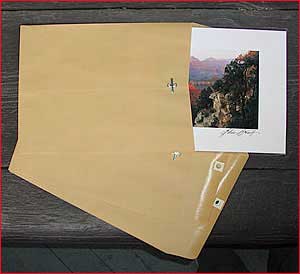
A simple, inexpensive and attractive way to package prints after sale: standard 9×12 envelopes. In boxes of 100 they cost around $6 per box, only 6 cents per sale.

A necessary convenience. Notice that it matches my print bins.
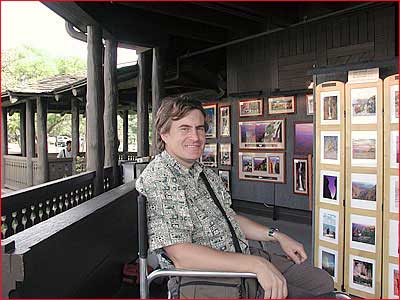
Once the show is set up all you have to do is kick back and wait for the customers.
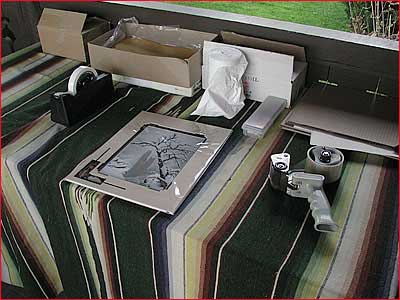
An impromptu outdoor frame shop. We routinely reframe and re-mat artwork to fit customer’s taste. Notice the roll of tape to tape photographs to mats. The boxes contain unmatted photographs. Also notice the tape gun to package sold items and the roll of white plastic bags to bag large purchases. These are available at Wal Mart for about $5 a roll.

Essential framing tools include a Fletcher framing staple gun, extra staples, pliers, wire cutter, and screwdriver. With those I can take a photograph out of a frame and reframe it in a different frame in a matter of minutes. Being able to change frames, and mats, is a service very much appreciated by customers.
How to Find Shows?
The best reference I know of is a magazine called “Sunshine Artist.” Sunshine Artist not only lists shows across the United States but also ranks them according to their popularity, how well they are organized, and how much attendance they receive. The other great thing about this magazine is that their web site lists many resources needed to do shows such as equipment, supplies, etc. Their “resource” page which lists many valuable links.
Sunshine Artist Magazine
3210 Dade Ave.
Orlando, FL 32804
Phone: (407) 228-9772
FAX: (407) 228-9862
Another good source of information is your local Chamber of Commerce which will have the names of show organizers in your area.
Where to Get Your Show Equipment?
In this article I provide you with the phone number of the display manufacturer I use. Another company I order from is “Dealer Supply“. However I do not have their contact information right now (I just moved and most of my files are still in packing boxes). However this manufacturer advertises inSunshine Artist Magazine.
Here is a link to a booth and display manufacturer:http://www.flourish.com/and a link to their “resources” page which lists other manufacturers as well as other magazines listing shows:http://www.flourish.com/lynx.htm.
Conclusion
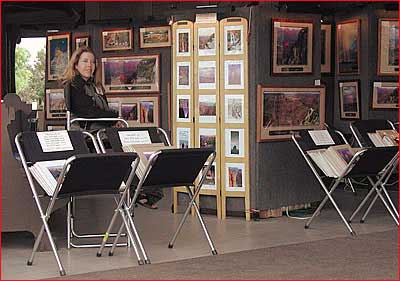
An attractive display and a smile. The two keys elements of a successful show.
Doing shows can be a great way to sell your work and to make a handsome income doing so. But it can also be a very frustrating activity if you do not approach this endeavor in the correct manner. Planning your show, your display and your setup is the key to avoid frustration and reach the success you deserve. You can use as much of my approach as you want if it helps you, or as little of it as you want if you prefer to do things differently. If you need help you canemail meyour questions and I will do my best to answer them in a helpful manner.
Where do you go from here?
At this point you may have many questions about where to get equipment, how to price your work, how many pieces you need to take to a show and more. All these questions, and many more, are answered in my book:Marketing Fine Art Photography. This book is available both as aprinted bookand as aneBook.
If you want to go further, I also offer an in-depth tutorial titled theMarketing Mastery Workshop on DVD. Finally, if you need personalized help, I offer one on one consultingover the phoneandin my studiofor marketing and other aspects of photography.
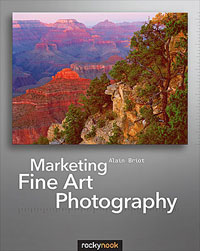
This is one of a regular series of articles titledBriot’s View
written exclusively for TheLuminous Landscape
byAlain Briot
You May Also Enjoy...
Video Clips
This Page Contains Links to a Few SelectedPreview Video Clips From The Current Issue ofThe Luminous Landscape Video Journal. These low-resolution video clips are in QuickTime
Spring is Almost Here Contest
The winner of the Nikon D300 is M.N. Hutchinson of Alberta,and the winner of the Canon G9 camera is Konstantin Dubinets of New York.Congratulations to
